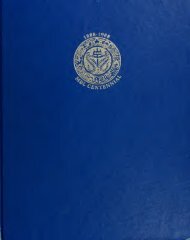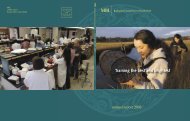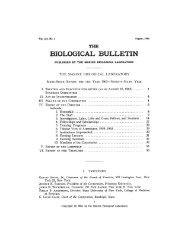View/Open - HPS Repository
View/Open - HPS Repository
View/Open - HPS Repository
Create successful ePaper yourself
Turn your PDF publications into a flip-book with our unique Google optimized e-Paper software.
often give the impression of being three-dimensional.<br />
Textbook and atlas have been combined in order to facilitate the study of<br />
text and figures together. The figures corresponding to the text are unavoidably<br />
spread over several preceding and following pages. In a separate atlas<br />
they might have been more easily grouped together. The sequence of the individual<br />
chapters and subdivisions seems at some points somewhat subjective;<br />
the teeth might, in our opinion, better be discussed together with the skeleton.<br />
This anatomical textbook and atlas surely belongs to the best works on<br />
human anatomy, and is published with very great care and technical skill. It<br />
can therefore be warmly recommended to all medical students and physicians<br />
sufficiently acquainted with the German language. After the recent death of<br />
the author, this new edition forms a lively expression and memory of his great<br />
scholarship.<br />
P. D. NIEUWKOOP<br />
"EMBRYOLOGIE,<br />
ein Lehrbuch auf allgemein biologischer Grundlage"<br />
1955<br />
by D. Starck Georg Thieme Verlag, Stuttgart<br />
688 pp. with 502 figs, partly in colour. Price: 78.— D.M.<br />
and a tabular appendix<br />
This extensive textbook on embryology, in which the author has tried to<br />
make a synthesis of comparative and experimental embryology, has not only<br />
been written for students, but also for scientific workers in the field of medicine<br />
and biology.<br />
In the first, general part of this textbook, attention has been paid to the<br />
development and structure of the germ cells, the processes of meiosis and fertilization<br />
and their genetical aspects, after which cleavage, gastrulation and<br />
early development have been described. After a short description of the early<br />
development of some groups of meroblastic Vertebrates, the early development<br />
and placentation of the mammalian embryo has been treated extensively. In this<br />
general part of the book some principal results of experimental analysis have<br />
been given. Some small chapters on functional adaptation during development<br />
and on the various types of ontogenesis and their evolutionary significance<br />
conclude this part of the book.<br />
The second part of the book deals with the organ development of the mammalian<br />
embryo, particularly of man, while malformations and their morphogenetic<br />
origin are extensively discussed. Finally a more theoretical chapter has<br />
been devoted to the organisation of the vertebrate body and in particular to the<br />
head problem.<br />
We appreciate it very much that the human embryology is placed in the<br />
wider field of the general mammalian development by showing the many-sided<br />
comparative embryological aspects of human development. We must however<br />
confess that we are less enthusiastic about the synthesis of experimental and<br />
comparative embryology. Although we appreciate the initiative of the author,<br />
and believe that it will certainly stimulate further work in this direction, we feel<br />
that the author has given himself too heavy a task. Since he is himself a descriptive<br />
and comparative embryologist, the results of experimental embryology<br />
are given second place. The data given form in many cases a subjective choice<br />
out of the still controversial literature. The chapters on experimental embryol-<br />
191
















